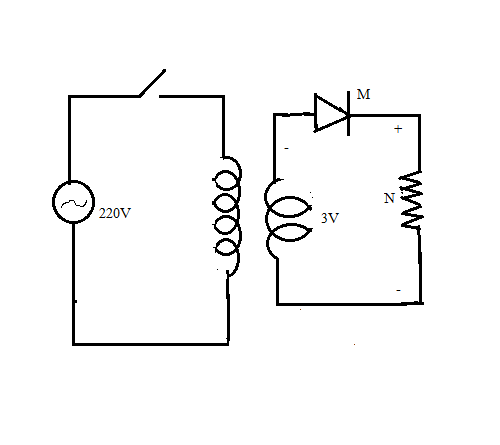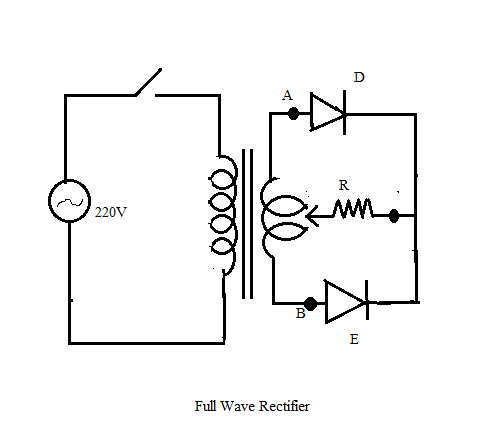
Analyse the given circuit diagram of a half wave rectifier and answer the following questions.
a. Identify the components labelled as M and N.
b. What are the changes to be made in the following components for the converting this to a full wave rectifier
i. Transformer
ii. No. of Diodes
iii. Draw the output form of a full rectifier.


Answer
584.7k+ views
Hint: In a half wave rectifier there always remains a diode, a load resistance, a transformer and an A.C input. Again, for a full wave rectifier, there are two diodes instead of one and there is a load resistance, a transformer and an A.C input.
Complete step-by-step answer:
a) The component labelled as M is a diode and the diode in a half wave rectifier is forward biased. The component labelled N is a load resistance. As the diode M is forward biased, it allows the flow of current through the circuit.
b) For the half wave rectifier to be changed to a full wave rectifier, the change in the given components should be as follows-
i. In case of a full wave rectifier, the transformer should be a centre-tap transformer.
ii. There are two diodes in case of a full wave rectifier, one of the diodes is forward biased and the other is reverse biased.
The output form of a full wave rectifier is given below,

Note: Students must be very careful about the fact that in a full wave rectifier, one of the diodes is reverse biased and the other is forward biased. As a result, current flows only through one diode, that is through the diode which is forward biased. They must also pay attention towards the use of a centre-tap transformer in case of a full-wave rectifier.
Complete step-by-step answer:
a) The component labelled as M is a diode and the diode in a half wave rectifier is forward biased. The component labelled N is a load resistance. As the diode M is forward biased, it allows the flow of current through the circuit.
b) For the half wave rectifier to be changed to a full wave rectifier, the change in the given components should be as follows-
i. In case of a full wave rectifier, the transformer should be a centre-tap transformer.
ii. There are two diodes in case of a full wave rectifier, one of the diodes is forward biased and the other is reverse biased.
The output form of a full wave rectifier is given below,

Note: Students must be very careful about the fact that in a full wave rectifier, one of the diodes is reverse biased and the other is forward biased. As a result, current flows only through one diode, that is through the diode which is forward biased. They must also pay attention towards the use of a centre-tap transformer in case of a full-wave rectifier.
Recently Updated Pages
Master Class 12 Business Studies: Engaging Questions & Answers for Success

Master Class 12 Economics: Engaging Questions & Answers for Success

Master Class 12 English: Engaging Questions & Answers for Success

Master Class 12 Maths: Engaging Questions & Answers for Success

Master Class 12 Social Science: Engaging Questions & Answers for Success

Master Class 12 Chemistry: Engaging Questions & Answers for Success

Trending doubts
What are the major means of transport Explain each class 12 social science CBSE

Which are the Top 10 Largest Countries of the World?

Draw a labelled sketch of the human eye class 12 physics CBSE

How much time does it take to bleed after eating p class 12 biology CBSE

Explain sex determination in humans with line diag class 12 biology CBSE

Differentiate between homogeneous and heterogeneous class 12 chemistry CBSE




